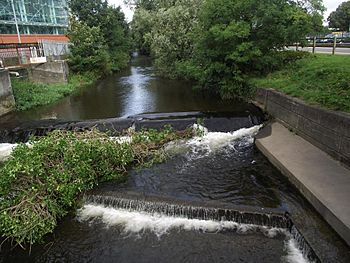River Douglas (Isle of Man) facts for kids
Quick facts for kids River Douglas |
|
|---|---|
 |
|
| Country | Isle of Man |
| City | Douglas |
| Physical characteristics | |
| Main source | Confluence of River Glass & River Dhoo 13 m (43 ft) 54°09′04″N 4°30′07″W / 54.151°N 4.502°W |
| River mouth | Douglas Harbour 0 m (0 ft) 54°08′46″N 4°28′16″W / 54.146°N 4.471°W |
| Length | 2.3 km (1.4 mi) |
The River Douglas is a short but important river on the Isle of Man. It flows through the town of Douglas, which is the capital of the island. This river plays a key role in the town's history and its modern-day look.
Contents
Where the River Begins
The River Douglas doesn't start from a single spring. Instead, it forms when two other rivers meet. This meeting point is called a confluence.
The River Glass and River Dhoo
The River Douglas begins just outside the main part of Douglas town. It is created by the joining of two smaller rivers:
- The River Glass
- The River Dhoo
These two rivers flow down from higher ground on the island. When they come together, they form the River Douglas.
Journey to the Sea
Once formed, the River Douglas flows a short distance before reaching the sea.
Flowing Through Douglas
The river travels about 2.3 kilometers (1.4 miles) through the town. It passes by different parts of Douglas before reaching its final destination.
Reaching Douglas Harbour
The River Douglas ends its journey by flowing into Douglas Harbour. This is a busy port where boats and ships come and go. The river's water mixes with the sea water here, eventually joining the Irish Sea.
Importance of the River
Even though it's a small river, the River Douglas is very important to the town it's named after.
Shaping the Town
Historically, rivers were vital for towns. The River Douglas helped shape Douglas into the capital it is today. It provided fresh water and was important for trade and transport in the past.
Modern Day Role
Today, the river is still a notable feature of Douglas. It adds to the town's scenery and is part of the local environment. You can often see weirs, which are small dams, along its path, helping to control the water flow.

